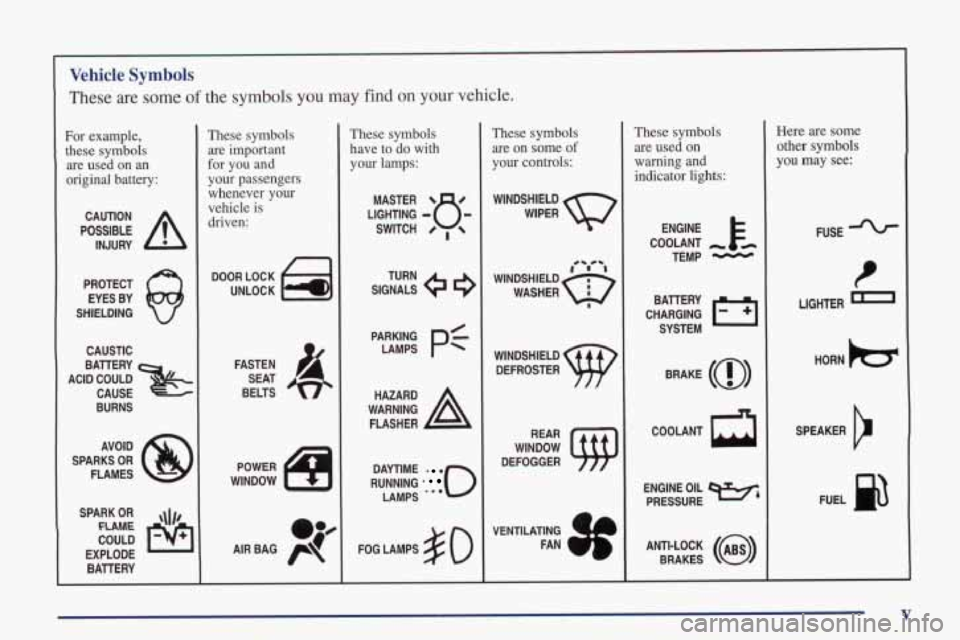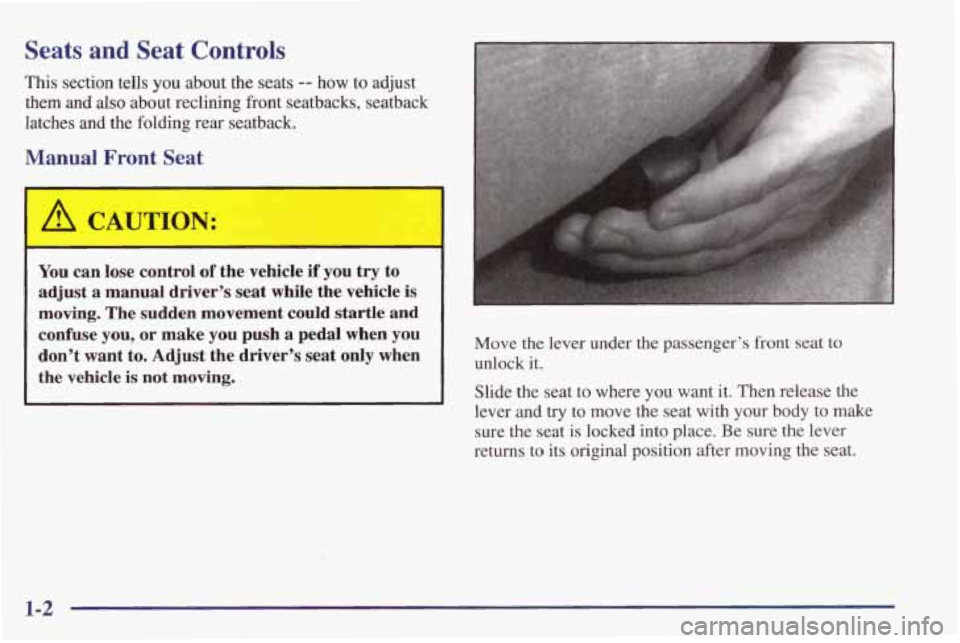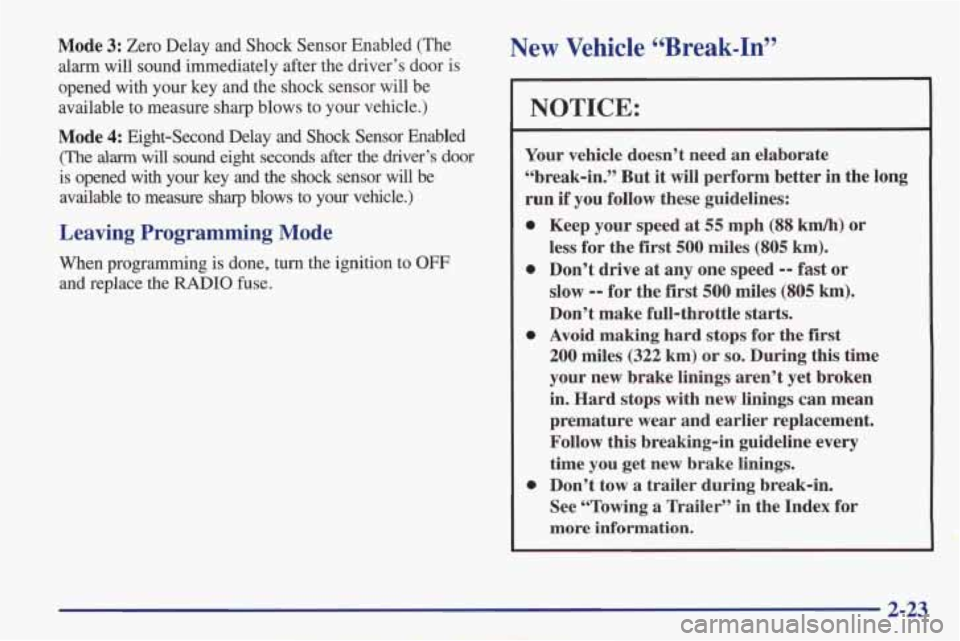fuse PONTIAC FIREBIRD 1998 Owners Manual
[x] Cancel search | Manufacturer: PONTIAC, Model Year: 1998, Model line: FIREBIRD, Model: PONTIAC FIREBIRD 1998Pages: 406, PDF Size: 18.23 MB
Page 6 of 406

Vehicle Symbols
These are some of the symbols you may find on your vehicle.
For example,
these symbols are used on an
original battery:
POSSIBLE A
CAUTION
INJURY
PROTECT EYES BY
SHIELDING
CAUSTIC
BURNS
SPARK
OR ,\I/,
COULD
FLAUE
EXPLODE BAllERY
These symbols are important
for you and
your passengers whenever your
vehicle
is
driven:
DOOR LOCK
UNLOCK
FASTEN SEAT
BELTS
e?
AIR BAG p
These symbols
have to do with
your lamps:
SIGNALS @ 9
TURN
PARKING
pf
LAMPS
RUNNING
' 0
DAYTIME * 0
LAMPS
FOG LAMPS
$0
These symbols
are on some of
your controls:
WIPER 9
WINDSHIELD
DEFROSTER
WINDOW
DEFOGGER
VENTILATING
'*
FAN '-d
These symbols are used on
warning and
indicator lights:
COOLANT
TEMP
-
CHARGING I-1
BATTERY
SYSTEM
BRAKE
(a)
COOLANT a
ENGINE OIL
PRESSURE
ANTI-LOCK
(@)
BRAKES
Here are some
other symbols
you may see:
FUSE
P
LIGHTER -
HORN )d.
SPEAKER
k
FUEL la
V
Page 9 of 406

Seats and Seat Controls
This section tells you about the seats -- how to adjust
them and
also about reclining front seatbacks, seatback
latches and the folding rear seatback.
Manual Front Seat
I A CAUTION:
You can lose control of the vehicle if you try to
adjust a manual driver’s seat while the vehicle
is
moving. The sudden movement could startle and
confuse you, or make you push a pedal when you
don’t want to. Adjust the driver’s seat only when
the vehicle
is not moving.
I
Move the lever under the passenger’s front seat to
unlock it.
Slide the seat to where
you want it. Then release the
lever and
try to move the seat with your body to make
sure the seat is locked into place. Be sure the lever
returns to its original position after moving the seat.
1-2
Page 64 of 406

Transmitter Verification (If Equipped)
This feature provides feedback to the holder of the
remote keyless entry transmitter that a command has
been received by the Remote Lock Receiver. The parking lamps will flash on every lock and unlock
command and the horn will sound only if the LOCK
button
is pressed twice within five seconds. This allows
for silent operation of locking and unlocking unless
a
confirming horn chirp is desired. Other options may be
selected
for this feature (see “Feature Customization” in
the Index).
Matching Transmitter(s) To Your Vehicle
Each remote keyless entry transmitter is coded to
prevent another transmitter
from unlocking your vehicle.
If a transmitter is lost
or stolen, a replacement can be
purchased through your dealer. Remember to bring any
remaining transmitters with you when you go to your
dealer. When the dealer matches the replacement
transmitter to your vehicle, any remaining transmitters
must also be matched. Once your dealer has coded
the
new transmitter, the lost transmitter will not unlock your
vehicle. Each vehicle can have only four transmitters
matched
to it.
Have each transmitter you intend to match ready for the
next steps.
To match transmitters to your vehicle:
1. Turn the ignition to RUN, then to OFF. This will
disarm the Content Theft-Deterrent System (if your
vehicle has this option).
2. Remove the RADIO fuse. This fuse is located in the
main fuse block, which is located
on the left side of
your instrument panel. The RADIO fuse is located
on the lower right hand corner of the panel. See
“Fuses and Circuit Breakers”
in the Index.
3. Turn the ignition fi-om OFF to RUN three times quickly
(within five seconds). The vehicle
will respond by
locking the
doors, unlocking the driver’s door and
releasing the hatch. Your transmitter is now ready to
match your vehicle. Leave the ignition in RUN.
4. Press and hold the LOCK and UNLOCK buttons on
the first transmitter for up to
15 seconds. The vehicle
will respond as in Step
3.
5. Repeat Step 4 for the remaining transmitters.
6. When you have finished matching all of your
transmitters, replace
the RADIO fuse.
7. Check that all transmitters work by pressing their buttons.
If the transmitters don’t work, or if you’d rather not
match the transmitters yourself, see your Pontiac dealer.
Page 72 of 406

PASS-Key@ I1
Your vehicle is equipped
with the PASS-Key
II
(Personalized Automotive
Security System)
theft-deterrent system.
PASS-Key
I1 is a passive
theft-deterrent system. It
works when you insert or
remove the key from
the ignition.
PASS-Key I1 uses a resistor pellet in the ignition key
that
matches a decoder in your vehicle.
When the PASS-Key
I1 system senses that someone is
using the wrong key, it shuts down the vehicle’s starter and fuel systems. For about three minutes, the starter
won’t work and fuel won’t
go to the engine. If someone
tries to start your vehicle again or uses another key during this time, the vehicle
will not start. This
discourages someone from randomly trying different
keys with different resistor pellets in an attempt to make
a match.
The ignition key must be clean and dry before it’s
inserted in the ignition or the engine may not start. If the
engine does
not start and the SECURITY light stays on
when you try to start the vehicle, the key may be dirty or
wet. Turn the ignition off.
Clean and dry the key. Wait about three minutes and try
again. If the starter still won’t work, and the key appears
to be clean and
dry, wait about three minutes and try
another ignition key. At this time, you may also want to
check the fuses (see “Fuses and Circuit Breakers’’ in the
Index).
If the starter won’t work with the other key, your
vehicle needs service.
If your vehicle does start, the first
ignition key may be faulty. See your dealer or a
locksmith who can service the PASS-Key
11.
If you accidentally use a key that has a damaged or
missing resistor pellet, the starter won’t work. The
SECURITY light will flash. But you don’t have to wait
three minutes before trying another ignition key.
See your dealer or a locksmith who can service the
PASS-Key
I1 to have a new key made.
2-17
Page 74 of 406

To program features, your vehicle must be in the
programming mode. Follow these steps:
1. Put your key
in the ignition.
2. Turn the ignition to RUN to disarm the Content
Theft-Deterrent System.
3. Turn the ignition to OFF.
4. Remove the RADIO fuse. This fuse is in the main
fuse block, located on the left side of your
instrument panel. See “Fuses and Circuit Breakers”
in the Index.
5. Turn the ignition to ACC.
You should hear a chime to verify that the system is
in the programming mode. If the chime sounds once,
you will be able to program Exit Lighting, Delayed
Illumination, Last Door Closed Locking and Lockout
Prevention only.
If the chime sounds twice and your
vehicle is equipped with the Content Theft-Deterrent
System, you will also be able to program Remote
Keyless Entry Lock Control Verification, Arming
Method, Arming Verification, Driver’s Door Delay and Shock Sensor Enable.
Exit Lighting and Delayed Illumination
With Exit Lighting, your interior lamps will come
on for up to
25 seconds when the key is removed
from the ignition.
With Delayed Illumination, your interior lamps will stay on for up to
25 seconds when entering your vehicle and
up to five seconds when leaving your vehicle.
Your vehicle comes with both features enabled (Mode 4).
To change the factory setting, do the following:
1.
2.
3.
4.
Turn the courtesy lamps on by turning the instrument
panel brightness control knob all the way up.
Count the number of chimes you hear. The number
of chimes tells you which mode your vehicle is
set for.
Turn the courtesy lamp switch to
off.
Turn the courtesy lamp switch from on to off until
you hear the number of chimes that correspond to the
mode selection you want.
Mode 1: Both Off
Mode 2: Delayed Illumination Only
Mode 3: Exit Lighting Only
Mode 4: Both On
Page 78 of 406

Mode 3: Zero Delay and Shock Sensor Enabled (The
alarm will sound immediately after the driver’s door is
opened with your key and the shock sensor will be
available to measure sharp blows to your vehicle.)
Mode
4: Eight-Second Delay and Shock Sensor Enabled
(The alarm will sound eight seconds after the driver’s door
is
opened with your key and the shock sensor will be
available to measure sharp blows to your vehicle.)
Leaving Programming Mode
When programming is done, turn the ignition to OFF
and replace the RADIO fuse.
New Vehicle CCBreak-InS’
NOTICE:
Your vehicle doesn’t need an elaborate
“break-in.” But it will perform better
in the long
run
if you follow these guidelines:
0 Keep your speed at 55 mph (88 km/h) or
less for the
first 500 miles (805 km).
0 Don’t drive at any one speed -- fast or
slow
-- for the first 500 miles (805 km).
Don’t make full-throttle starts.
200 miles (322 km) or so. During this time
your new brake linings aren’t yet broken
in. Hard stops with new linings can mean
premature wear and earlier replacement.
Follow this breaking-in guideline every
time you get new brake linings.
See “Towing a Trailer’’ in the Index for
more information.
0 Avoid making hard stops for the first
0 Don’t tow a trailer during break-in.
2-23
Page 84 of 406

Engine Coolant Heater
(Canada Only)
In very cold weather, 0 OF (- 1 8 O C) or colder, the engine
coolant heater can help. You’ll get easier starting
and
better fuel economy during engine warm-up. Usually,
the coolant heater should be plugged in a minimum of
four hours prior to starting your vehicle.
To Use the Engine Coolant Heater
1. Turn off the engine.
2. Open the hood and unwrap the electrical cord.
The cord is attached to the outside
of the underhood
fuse
box.
3. Plug it into a normal, grounded 110-volt AC outlet.
A CAUTION:
Plugging the cord into an ungrounded outlet
could cause an electrical shock. Also, the wrong
kind
of extension cord could overheat and cause
a fire. You could be seriously injured. Plug the
cord into
a properly grounded three-prong
110-volt AC outlet.
If the cord won’t reach, use a
heavy-duty three-prong extension cord rated for
at least 15 amps.
2-29
Page 102 of 406

lhrn Signal and Lane Change Indicator
The turn signal has two upward (for right) and two
downward (for left) positions. These positions allow you
to signal a turn
or a lane change.
To signal a turn, move the lever all the way up or down.
When the turn is finished, the lever will retum automatically.
An arrow on the instrument
panel will flash in the
direction of the
turn or
1 lane change.
To signal a lane change, just raise or lower the lever
until
the arrow starts to flash. Hold it there until you
complete your lane change. The lever will return by
itself when you release it.
As you signal a turn or a lane change, if the arrows don’t
flash but just stay on,
a signal bulb may be burned out
and other drivers won’t see your
turn signal. If
a bulb is burned out, replace it
to help avoid an
accident. If the arrows don’t
go on at all when you
signal a turn, check the fuse (see “Fuses and Circuit
B&kers” in the Index).
Headlamp High/Low Beam
When the high-beams are
on, this light on the
instrument panel also will
be on.
To change the headlamps from low beam to high or
from high beam to low, pull the turn signal lever all the
way toward you. Then release it.
2-47
Page 116 of 406

NOTICE:
Don’t hold a cigarette lighter in with your hand while it is heating.
If you do, it won’t be able to
back away from the heating element when it’s
ready. That can make it overheat, damaging the
lighter and the heating element.
If you plug accessories into your cigarette lighter, such as heating devices
or air compressors, these accessories
should have a rated current
of less than 15 amps.
Exceeding this limit will result in a blown fuse.
Sun Visors
I
To block out glare, you can swing down the visors. You
can
also swing them to the side.
Visor Vanity Mirror
Pull down the sun visor and lift the cover to expose the
vanity mirror.
2-61
Page 256 of 406

You can be injured and your vehicle could be
damaged if you
try to do service work on a
vehicle without knowing enough about it.
0
0
Be sure you have sufficient knowledge,
experience, the proper replacement parts
and tools before you attempt any vehicle
maintenance task.
Be sure to use the proper nuts, bolts and
other fasteners. “English” and ‘5netric”
fasteners can be easily confused.
If you use
the wrong fasteners, parts can later break
or fall off. You could be hurt.
Adding Equipment to the Outside of
Your Vehicle
Things you might add to the outside of your vehicle can
affect the
airflow around it. This may cause wind noise
and affect windshield washer performance. Check with
your dealer before adding equipment to the outside
of
your vehicle.
Fuel
The 8th digit of your vehicle identification number
(VIN) shows the code letter for your engine. You will
find the VIN at the top left of your instrument panel.
(See “Vehicle Identification Number” in the Index.)
If you have the 3800 engine (VIN Code K), use regular
unleaded gasoline rated at
87 octane or higher.
If you have the
5.7L engine (VIN Code G), use
premium unleaded gasoline rated at
91 octane or
higher for best performance. You may use middle
grade or regular unleaded gasolines, but your vehicle
may not accelerate as well.
At a minimum, the gasoline you use should meet specifications ASTM
D48 14 in the United States
and CGSB
3.5-M93 in Canada. Improved gasoline
specifications have been developed by the American
Automobile Manufacturers Association (AAMA) for
better vehicle performance and engine protection.
Gasolines meeting the AAMA specification could
provide improved driveability
and emission control
system protection compared to other gasolines.
6-3